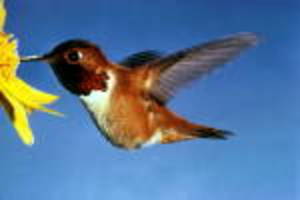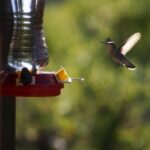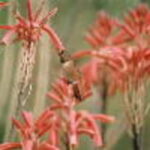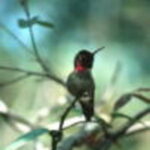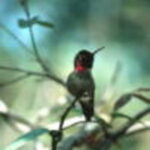Visitors and residents in Utah have the same opportunity to enjoy several species of hummingbirds throughout the year. These species of hummingbirds in Utah are the Broad-tailed Hummingbird, the Black-chinned Hummingbird, the Rufous Hummingbird, the Costa’s Hummingbird, the Anna’s Hummingbird, the Calliope Hummingbird, the Broad-billed Hummingbird and the Magnificent Hummingbird.
The Broad-tailed Hummingbird is a common visitor to Utah, arriving early in May. The male Broad-tailed Hummingbird is identified by the rose-red feathers covering its breast, the white feathers covering its breast, the metallic green feathers that cover its back and crown and finally, its rounded tail feathers. The female Broad-tailed Hummingbird is identifiable by the black and white feathers covering its breast, the green feathers covering its crown and back, the rust colored feathers covering its sides and its tail that has green feathers in the center bordered by feathers that are rust colored on the end closest to the body, black in the center and white-tipped on the end. This species of hummingbirds spend breeding season in Utah, usually in streamside riparian habitats found in the lower valleys and higher elevations.
The Black-chinned Hummingbird is a common visitor to Utah, returning annually during the spring. The male Black-chinned Hummingbird is readily identified by the black feathers covering its throat, along with purple feathers that create a throat band and white feathers that create a collar. This male hummingbird also has green feathers that cover its breast, crown and back. The female Black-chinned Hummingbird is identified by the white feathers covering its breast, the black and white feathers spotting its throat, the buff colored feathers with white tips that covers its sides and the green feathers covering its crown and back. This species of hummingbirds in Utah is most likely to be found at low and mid-elevations where it will nest close to stream beds.
The Rufous Hummingbird is a common visitor to Utah during the fall migration, where it is generally a transient, meaning that it does not stay long. The male Rufous Hummingbird is identified by the orange-red feathers covering its throat, the non-iridescent rufous feathers covering its crown, sides and tail and the feathers that are green, the white feathers covering its breast and rufous or a combination of green and rufous covering its back. The female Rufous Hummingbird is identified by the green feathers covering its back and crown, the white feathers that cover its breast, the white and black feathers that streak its throat and the rufous tail feathers tipped with white.
The Costa’s Hummingbird is an uncommon visitor to Utah, meaning that the sightings of this species of hummingbirds in Utah have been inconsistent and the numbers of these hummingbirds is low. The male Costa’s Hummingbird is identified by the metallic green feathers covering its back, the violet colored feathers covering its crown and throat, the green feathers covering its breast and the feathers covering the sides of its throat that are very long. The female Costa’s Hummingbird is identified by the green feathers covering its crown and back, the white feathers covering its breast, the white and black feathers covering its throat, the buff colored feathers covering its sides and the white-tipped tail feathers. This species is only present in Utah from March through June and is seen annually in the Virgin River drainage in southwestern Utah.
The Anna’s Hummingbird is considered a rare visitor to Utah, meaning that this species of hummingbird is seen infrequently, but annually. It also means that this species is not seen in large numbers when visiting Utah. The male Anna’s Hummingbird is identified by the dark rose-red feathers covering its throat and crown, the gray feathers covering its breast and metallic green feathers covering its back. The female is identified by the light gray feathers covering its breast, the white and red feathers spotting the throat, the green feathers covering its back and the white-tipped tail feathers. If an Anna’s Hummingbird were seen in Utah, it would most likely be in the winter months. There are nine confirmed sightings from 1985 to 2004, ranging from March to December.
The Calliope Hummingbird is considered another rare visitor to the state of Utah and is most likely to be seen at a feeder or hummingbird garden during the spring and summer months in the mountainous regions. The male Calliope Hummingbird is identified by the white and purple feathers whiskering its throat as well as the metallic green feathers covering its back and crown. The female Calliope Hummingbird is identified by the white and black feathers streaking its throat, the green feathers covering its crown and back , the buff feathers covering its side and the tail feathers that are white-tipped at the corners.
The Broad-billed Hummingbird is an accidental visitor to Utah, meaning that this species is not expected to be seen in Utah and Utah is out of its normal migration range. However, there have been five documented sightings of this species of hummingbirds in Utah, ranging from 1978 to 2002. These sightings occurred from August to November, during the species winter migration. The male Broad-billed Hummingbird is identified by the metallic blue feathers covering its throat, the dark green feathers covering its back crown and breast and its bill that is bright red-orange with a black tip. The female Broad-billed Hummingbird is identified by the gray feathers covering its throat and breast, the green feathers covering its crown and extending down its back, the white-tipped tail feathers and the red-orange bill with a black tip.
The Magnificent Hummingbird is another accidental visitor to Utah, with eight sightings documented beginning in 1962 and ending in 2001. These eight sightings occurred during the spring migration, from May to August. the male Magnificent Hummingbird is identified by the dark green feathers covering its back, the purple feathers covering its forehead and extending over its crown, its metallic green feathers covering its throat and black feathers covering its breast. The female Magnificent Hummingbird is identified by the olive green feathers covering its back and extending on over its crown, gray feathers covering its breast, gray and white feathers streaking down its throat and pearl-tipped tail feathers.
